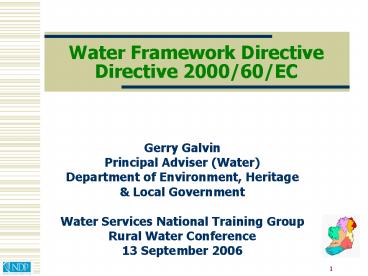Water Framework Directive Directive 200060EC - PowerPoint PPT Presentation
1 / 26
Title:
Water Framework Directive Directive 200060EC
Description:
Shannon IRBD. North Western IRBD. Neagh Bann IRBD. North-Eastern RBD NI. 5 ... ECJ Judgment against Ireland 11 March 2004 ... of Ireland's negotiating ... – PowerPoint PPT presentation
Number of Views:26
Avg rating:3.0/5.0
Title: Water Framework Directive Directive 200060EC
1
Water Framework Directive Directive 2000/60/EC
- Gerry Galvin
- Principal Adviser (Water)
- Department of Environment, Heritage
- Local Government
- Water Services National Training Group
- Rural Water Conference
- 13 September 2006
2
Water Framework Directive 2000/60/EC
- to protect and enhance the status of aquatic
ecosystems (and terrestrial ecosystems and
wetlands directly dependent on aquatic
ecosystems) - to promote sustainable water use based on
long-term protection of available water resources
- to provide for sufficient supply of good quality
surface water and groundwater as needed for
sustainable, balanced and equitable water use - to provide for enhanced protection and
improvement of the aquatic environment by
reducing / phasing out of discharges, emissions
and losses of priority substances - to contribute to mitigating the effects of floods
and droughts - to protect territorial and marine waters
- to establish a register of 'protected areas' e.g.
areas designated for protection of habitats or
species.
3
Water Framework Directive
- Website www.wfdireland.ie
- The WFD objectives (apply to all waters)
- Attain at least good status by 2015
(restoration) - (ecological chemical for surface waters)
- (quantitative qualitative for groundwaters)
- Ensure no deterioration in status
4
River Basin Districts
South Eastern RBD Western RBD Eastern RBD South
Western RBD Shannon IRBD North Western IRBD Neagh
Bann IRBD North-Eastern RBD NI
5
Water Framework Directive River Basin Planning
Cycles
6
Water Framework Directive
- Rivers, Lakes, Canals
- Groundwaters
- Coastal Waters
- Transitional Waters i.e. estuaries
7
Water bodies management units
8
Pressures Impacts Assessment Guiding Principles
- Analysis must be transparent, comprehensible
all data should be publicly available - Risk analysis is not status classification
- Risk assessment is to help identify prioritise
follow-up actions leading to next stages of the
planning process - Harmonised application of the key issues e.g.
baseline scenario the identification of heavily
modified water bodies - Lack of data - no excuse must demonstrate that
you tried - gap analysis
9
Pressures Impacts Assessment Risk Assessments
- STEP 1 Identification of Human Pressures
- Data collection by RBD projects and state
organisations - Nationally available data sets
- Data confidence assessed
- Address gaps by further data collection and
monitoring programmes
10
Pressures Impacts Assessment Risk Assessments
- STEP 2 Application of Risk Assessment
Procedures - Develop and apply assessments for all water
categories - Standardised approach adapted from UK
methodologies background documents available - Groundwater bodies conceptual understanding
using pressure pathway receptor approach - Surface water bodies empirical relationships
using established impact databases - Preliminary screening level assessments to be
developed to more quantitative approaches by 2008
11
Risk Assessment - Pressures
- Abstractions
- Morphological alterations
- Point source pressures
- Diffuse source pressures
12
What did Characterisation tell us?
- It was an estimate of where risk might occur
based on the best data and methods available.
There was a lot of inherent uncertainty. - It will guide where sampling will be carried out
therefore reducing the amount of uncertainty. - It will guide the development of the Programmes
of Measures. - It provided a baseline against which future water
status will be measured.
13
National Results - Summary
14
Groundwater
15
Groundwater
16
Rivers
17
Rivers
18
Lakes
19
Further Characterisation
- Groundwaters
- Guidance in relation to-
- Mining
- Contaminated land
- Quarries
- Landfill
- Diffuse Pressures
- Abstraction pressures
20
River Basin Management Process
Monitor water bodies
This is a complex process ! What objectives
apply ? Which pressures ? What are key risk
factors ? What are technical options ? What are
the most cost effective measures ? What is a
realistic timeframe for implementation ?
21
Other issues
- Data management and electronic reporting
- Harmonisation
- Economic analysis
- Consultation
- Progress Reporting
- Regulatory Framework
22
Nitrates Regulations where are we?
- ECJ Judgment against Ireland 11 March 2004
- Revised Action Programme sent in Oct. 2004
(Brosnan Recommendations) - Rejected by Commission Letter of Formal Notice
Dec. 2004 - Consultations with Commission and Farming
Organisations - Regulations made in July 2006
- Regulations to take effect from 1st August 2006
- Derogation being sought for intensive farming
Implementation of binding rules to give legal
effect to good farming practice will be critical
to Ireland meeting its obligations under the WFD
23
Other risks (if we falter)
- Threat of daily fines
- Weakening of Irelands negotiating position
- on proposed revisions of measures under CAP RDP
e.g. REPS, Compensatory Allowances, Forestry and
the Early Retirement Scheme - on discussions on the next round of rural
development funding (2007 2013)
24
On-farm manure storage and closed periods
- 26 weeks storage for pigs and poultry
(generally) - 6 weeks storage for deer, goats and sheep
- reduced storage permitted where animals are
outwintered (extensive farmers only and dairy
cows excluded)
25
How are we performing among EU Member States ?
26
Thank You
- www.wfdireland.ie































